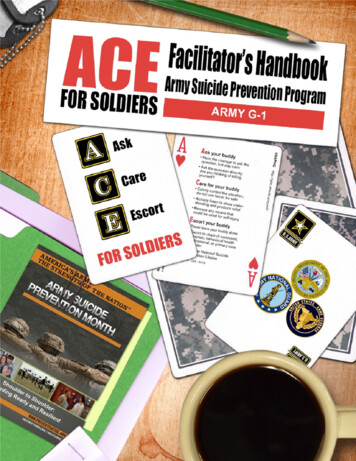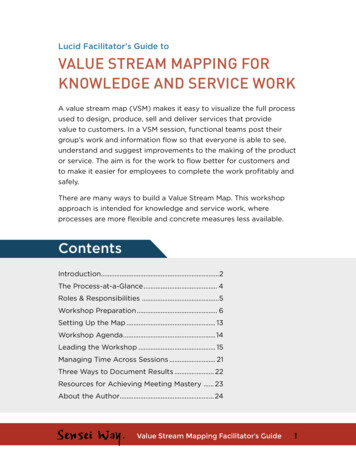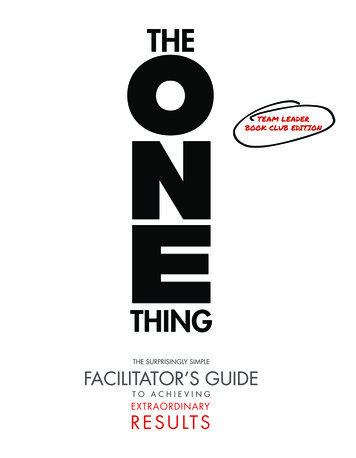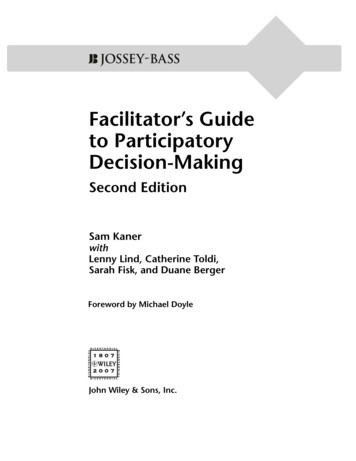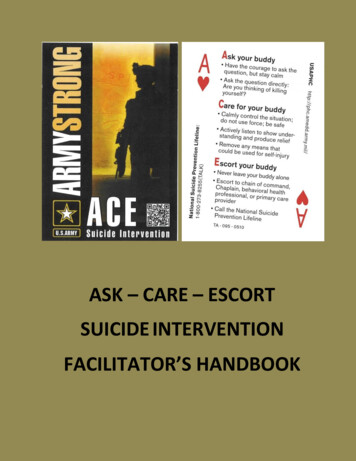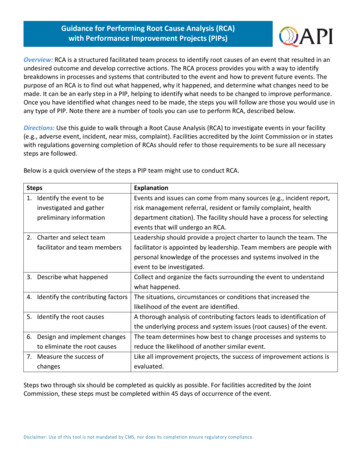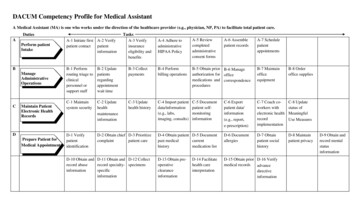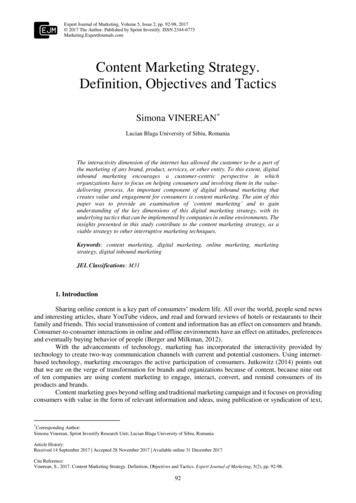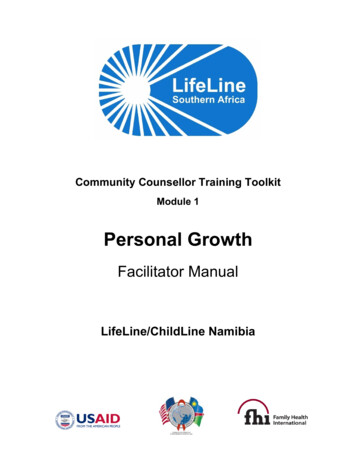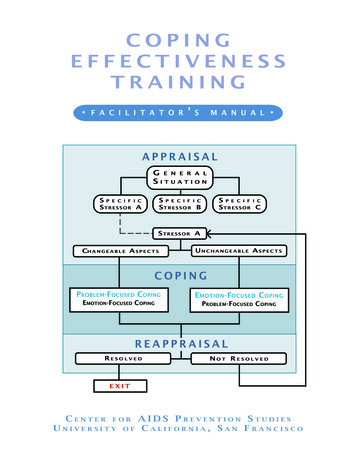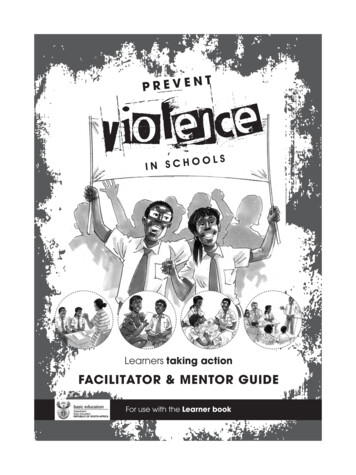
Transcription
Learners taking actionFACILITATOR & MENTOR GUIDEFor use with the Learner book
ACKNOWLEDGEMENTSISBN: insert The programme Prevent violence in schools is part of a wider initiative, Safer South Africa for Women andChildren, launched in 2012 by Save the Children South Africa, the United Nations Children's Fund (UNICEF) andthe United Nations Population Fund (UNFPA), in partnership with the Department of Basic Education and fundedby DfiD. Prevent violence in schools focuses on enabling and supporting learners to take action to preventviolence in their own schools.The programme materials were developed by writers from Save the Children South Africa and MIET Africa inpartnership with DBE and UNICEF. Content development was informed by a workshop with learners held in theFree State during 2014, and the materials were reviewed at various stages of development by a review teamdrawn from all the partner organisations. This material will be further field tested with district officials from 86 districtsand thereafter finalised. Please send all comments and suggestions to the Department of Basic Education, PrivateBag X895, Pretoria, 0001.Progamme materials include two publications: Prevent violence in schools. Learners taking action. Learner book Prevent violence in schools. Learners taking action. Facilitator and mentor guideMaterials review team: Dululu Hlatshaneni (DBE); Nokuthula Prusent (UNICEF);Gilles Virgili and Solly Matile (Save the Children); Jan van Zyl and Maureen King (MIET Africa)MIET Africa materials development and production team: Jane Jackson (main writer);Shirley Moon (main editor); Beverley Dyason; Daniela McCulloughIllustrations: A. Valentim JuniorDesign and layout: sarahscottdesignPublished by MIET Africawww.miet.co.zaThe DBE acknowledges the generous support of UNICEF for funding the developmentof the materials and programme implementation.2
FACILITATOR & MENTOR GUIDECONTENTSAcronyms5Glossary6Introduction71. Background: Violence in our schools and communities7What does this mean for learners in our schools?7Laws on sexual abuse of learners, and the meaning of 'consent'82. What is the Prevent violence in schools programme?10Workshop for learners on taking action against violence at school10Learners implement action steps at school10School-based mentoring to support learner action103. Learner participation is crucialWhich learners will participate in the workshop and lead action at school?4. What are the roles of the facilitator and the mentor?111112Dealing with sensitive topics12Part 1: facilitating the workshop141. The purpose of the workshop142. Workshop materials143. Facilitating the workshop15Working with a co-facilitator15Tips for facilitating sessions16Dealing with sensitive topics in workshops17Workshop planning checklist18Workshop resource checklist19Workshop structure, objectives and summary20Structure for delivering the workshop modules22Module 1: Introduction to Prevent violence in schools23Module 2: Understanding violence25Module 3: Gender-based violence27Module 4: Analysing violence31Module 5: Reporting violence34Module 6: My school, my reality36Module 7: Taking action38Conclusion: The way forward423
FACILITATOR & MENTOR GUIDECONTENTSPart 2: mentoring school safety teams431. What is the mentoring programme in prevent violence in schools?43What is mentoring?43What does this mentoring programme aim to achieve?43Who will mentor learners in the programme?43What are the mentors required to do?442. Mentoring in a youth-led action programmeWhat are the advantages of a mentoring programme?44What role and approach does the mentor take in this kind of programme?44What challenges will your learners face?45What kinds of mentoring are generally needed in a school action programme?46What qualities should mentors have?46What sort of relationship should mentors have with learners?47How should mentoring sessions be structured?49How long should mentoring continue?49What if mentors need support?503. Managing the mentoring programme51Become familiar with the workshop content and experience51Get to know your learners51Provide site-based support at schools52Plan your mentoring52Develop networks and partnerships52Ensure activities are conducted efficiently and in good time53Track learner progress and report on the action programme544. Mentoring learners through the action steps44455The nine action steps: the 'deliverables' of the programme55Dealing with ongoing mentoring concerns56Collecting evidence of learners' progress57Supporting step 1: Get the support of the principal and a teacher champion58Supporting step 7: Implement violence-prevention activities58Supporting step 8: Report on achievements59Supporting step 9: Plan a new round of action59References60Appendix 1: Timetable for a three-day workshop programme61Appendix 2: Mentoring record63Appendix 3: Summary of Child Justice Act 200864
ACRONYMSARV. AntiretroviralCBO. Community-Based OrganisationDBE. Department of Basic EducationFBO. Faith-Based OrganisationGBV. Gender-Based ViolenceMAP. Morning-After PillNGO. Non-Governmental OrganisationNSSF. National School Safety FrameworkSACE. South African Council of EducatorsSAPS. South African Police ServiceSGB. School Governing BodyUNFPA. United Nations Population FundUNICEF. United Nations Children's FundVEP. Victim Empowerment Programme5
GLOSSARYGenderIdeas about how men and women should behave and what roles andresponsibilities they should take in lifeGender stereotypesFixed ideas about how men/boys and women/girls behave. Suchstereotypes are not trueLearners' Code of ConductA document that sets out what behaviour is acceptable and notacceptable in the schoolMentorAn experienced person who advises and supports you over a period oftimeMorning-After Pill (MAP)An emergency contraceptive pill that may prevent pregnancy if takenas soon as possible, and within 72 hours (3 days) after sexPerpetratorA person who does something bad/wrong/illegal, e.g. uses violenceagainst someonePost-exposure prophylaxisA treatment that is used after sexual abuse to reduce the risk of HIV(PEP)infection. This treatment should be taken as soon as possible, andwithin 72 hours (3 days) after the incidentProblem treeA tool to help understand causes and consequences (results) of a problemissue (e.g. violence)RapeAny sexual act, or attempted sexual act, that involves someone puttinga penis or a finger or any object into the mouth, anus or vagina of someoneelse against their willSchool safety committeeA group that has been selected to look at safety in a school and has theduty to take disciplinary action against violence at school; it should includelearner representatives such as a member or members of the school safetyteamSchool safety teamA group of learners who are committed to working together to take actionagainst violence in their schoolSugar daddy/mommyAn older man or woman, who gives money or gifts to a younger personin return for sexual favoursVictimA person who is harmed because of something bad that happens tothem e.g. violence/crime/sexual abuse. We can also call this person asurvivor, to show that they have power to get over the bad experienceand healVictim EmpowermentA programme put in place by SAPS to support victims/survivors of sexualProgramme (VEP)abuse when they report the incidentViolenceWhen we use (or threaten to use) power or force to cause physical and/orpsychological harm to ourselves or others; violence is intentional (doneon purpose)6
Welcome to Prevent violence in schools, a school-based, youth-led programme aimed at tackling the rootcauses of violence, especially gender-based violence, in schools.This Facilitator and mentor guide includes: Introduction: background and origin of the programme, description of the different parts of the programmeand the programme approach Part 1: Facilitating the workshop: guidelines for the workshop training of learners targeted in the programme Part 2: Mentoring school safety teams: advice for mentoring these learners as they plan and take actionto prevent violence in their schools.You will also need: Learner book: contains the workshop materials the learners will need. It is also a stand-alone resource thatlearners can use for information and advice throughout the action process at school. The facilitator and mentorneed to be familiar with the contents of the Learner book.INTRODUCTION1. BACKGROUND: VIOLENCE IN OUR SCHOOLS AND COMMUNITIESThe high level of violence in South African schools (Burton and Leoschut, 2013) robs learners of their rights to dignityand equality, enshrined in the Bill of Rights of the Constitution of the Republic of South Africa (1996). It also preventsthem from getting the full benefits of their schooling and so realising their right to education.Victims of violence experience trauma that can have serious physical, psychological and emotional consequences.Violence can affect their personal development and their learning potential, and thus limit their future prospects.Frequently, violence takes the form of serious physical and sexual assault. This may result not only in emotionaltrauma but also in unwanted pregnancies and diseases such as HIV infection.What does this mean for learners in our schools?'When school-based violence and abuse put children's physical and psychological well-being at risk, their rightsto education and protection are neither respected nor fulfilled. Schools play an important role in providing asafe and supportive environment for children to grow up in. Schools should be free from violence and discriminationand should promote responsibility, participation and democracy, and help each child develop to its full potential'(Save the Children, 2011).Although available figures on the rate of violence against children are alarming, we do not even know the fullextent of the problem. The Medical Research Council (MRC) has suggested that only one in 25 rapes is reported.This is because (amongst other factors) many victims fear they will be stigmatised. They also fear secondaryvictimisation at the hands of the criminal justice system, which fails to convict many perpetrators. According tothe MRC study, in 2011 three children were murdered every day in South Africa and the nation had an overallchild homicide rate of 5.5/100 000 population. The MRC noted that child homicide in South Africa has a distinctlygendered pattern and most of the murdered children in the younger age group are girls.Gender-based violence (GBV) is a global problem. Although it affects men, women and children, women andgirls are the most at risk of GBV and also the most affected by it. An estimated one in three women worldwidehas been beaten, pressurised into having sex or otherwise abused in her lifetime. According to the UN PopulationFund, almost 50% of all sexual assaults worldwide are against girls of 15 years and younger.While we should be concerned about the under-reporting of violence, the high rates of violence against childrensuggest that in countering violence in schools, an emphasis on reporting is not enough. Every learner should alsobe equipped both to speak out about violence against children and also to take action to prevent it, particularlyas crimes are also being committed by children themselves.7
Learners need to deepen their understanding of human rights. Everyone has the right to freedom and securityof the person, be they young, old, black, white, straight, gay or anything in between. The Constitution puts itclearly: Article 12 of the Bill of Rights states that:(1) Everyone has the right to freedom and security of the person, which includes the righta. not to be deprived of freedom arbitrarily or without just cause;b. not to be detained without trial;c. to be free from all forms of violence from either public or private sources;d. not to be tortured in any way; ande. not to be treated or punished in a cruel, inhuman or degrading way.(2) Everyone has the right to bodily and psychological integrity, which includes the righta. to make decisions concerning reproduction;b. to security in and control over their body; andc. not to be subjected to medical or scientific experiments without their informed consent.Laws on sexual abuse of learners, and the meaning of 'consent'South African SchoolsAct, Section 8 1996Requires adoption of a learner Code of ConductPublic school governing bodies must adopt a Code of Conduct for learnersaimed at establishing a disciplined and purposeful environment for learnersDomestic ViolenceAct 1998Makes educator reporting of all abuse mandatoryPlaces a legal obligation on educators to report any form of maltreatment,neglect, abuse, or degradation of children to the Department of SocialDevelopment or the policeThe Employment ofEducators AmendmentAct 2000Provides for educator dismissalEducators who have committed sexual offences or had a sexual relationshipwith a learner can be dismissedSouth African Councilfor Educators Act 2000Provides for deregistration of educatorsWhen an educator is dismissed on the basis of sexually abusing a learner,he/she is also deregistered as an educator and cannot be appointed againby any education providerThe Code of Conductfor Educators (SACE)2007An educator refrains from improper physical contact with learners refrains from any form of sexual harassment (physical or otherwise) of learners refrains from any form of sexual relationship with learners at any schoolChildren's Act 2005Sets requirements for reporting abuse and supporting children who are abusedChildren's AmendmentAct 2007Compulsory reporting: professionals, including educators, must report suspectedchild abuse to the SAPS, provincial Department of Social Development or adesignated Child Protection Organisation (CPO)From the age of 12 years a person is entitled to confidential contraceptiveadvice and contraceptivesAlso mandates schools as employersSchools must ensure that they do not employ anyone on the National Registerof Persons Unfit to Work with Children, as they will become guilty of a criminaloffence if they employ such a person8
Sexual OffencesAmendment Act 2007Defines sexual offences, e.g. Rape is any form of sexual penetration (of genital organs, mouth or anus)by any object without consent, irrespective of the gender of perpetratorand victim Sexual violation is sexual contact (sexualised touching - or forcing someoneto touch - intimate parts), exposing children to pornography or using themfor pornography, or making them watch sex acts A person (“A”) who engages in sexual penetration or sexualcontact/stimulation with a child (“B”), is guilty of statutory rape or sexualviolation respectively, even if B consents If A and B were both children between 12 and 16 at the time of the offence,they can only prosecuted if the National Director of Public Prosecutionsauthorises it in writing. Under certain circumstances, the Director of PublicProsecutions can decide that sex between children aged 12 to 16 wasconsensual, and that they should not be prosecuted. (A child under theage of 12 is considered not to be capable of consenting to sexual actsunder any circumstances)Also mandates schools as employers Child Justice Act 2008Schools must ensure that they do not employ anyone on the NationalRegister of Sex offenders and thereby become guilty of a criminal offenceAims to set up a child justice system to ensure that children under the age of18, who are suspected of having committed crimes such as assault, publicviolence, culpable homicide, robbery, rape and murder, will not be dealt within terms of the criminal procedure used for adults. The act seeks to ensure thatchild justice matters will be dealt with in such a way as to help children suspectedof committing crimes to turn their lives around and become productive membersof society. For more information see Department of Justice and ConstitutionalDevelopment's summary of the Child Justice Act 2008 at the end of this Guide.(See also DoJ&CD Child Justice Act, 2008 (Act no 75 0f 2008) informationbooklet, available at www.justice.gov.za/vg/cj/2010 cj booklet a6.pdf)NOTE: THE LEGAL AGE OF CONSENT TO SEXUAL ACTS IN SOUTH AFRICA IS 16. STATUTORY RAPE IS SEXUALPENETRATION OF A CHILD UNDER 16.In 2007 amendments were made to the Children's Amendment Act and Sexual Offences Amendment Act toacknowledge the reality that in today's society children between 12 and 16 do sometimes choose to have sex(consensual sex) with each other. These amendments aim to protect these children by encouraging them to beresponsible and seek the help and advice they need, and for adults to give it, without fear of criminal prosecution.(1) The Children's Amendment Act allows children confidentiality when seeking contraceptives and contraceptiveadvice. (2) The Sexual Offences Amendment Act says that consensual sex between children aged 12 to 16 isnot automatically considered to be a criminal offence, at the discretion of the Director of Public Prosecutions.HOWEVER, THIS DOES NOT CHANGE THE FACT THAT IT IS A CRIME FOR AN ADULT TO HAVE SEX WITH A CHILDOF UNDER 16 EVEN IF THE CHILD CONSENTS.‘Consent’ means Voluntary or unforced agreement, i.e. the other person must freely, willingly and deliberately agree. When the other person understands what she/he is consenting to.‘Without consent’ means When the other person submits to a sexual act because s/he is forced, intimidated or threatened. When the perpetrator abuses his/her power or authority. When the other person is deceived into agreeing to the sexual act. When the other person is not able to think properly or understand the nature of the sexual act at the time, e.g.because she/he is asleep, unconscious, unable to think properly because of drugs or alcohol, has a mental disability.9
2. WHAT IS THE PREVENT VIOLENCE IN SCHOOLS PROGRAMME?Prevent violence in schools is part of a wider initiative, Safer South Africa for Women and Children, launched in2012 by Save the Children, the United Nations Children's Fund (UNICEF) and the United Nations Population Fund(UNFPA), in partnership with the Department of Basic Education (DBE). This initiative works with individuals andschool/community groups to boost prevention of violence against women and children. It therefore focuses ontransforming values and behaviours that have made violence (and especially GBV) 'normal' in our society. Bygoing to the roots of violence, this approach can bring about changes that are sustainable.The programme takes Safer South Africa for Women and Children into schools by supporting groups of learnersas they identify specific issues of violence in their own schools and take action to deal with these.The programme objectives are to: Build the capacity of learners to develop action plans on prevention of violence (GBV in particular) in the school Provide mentoring support to school-based youth structures as they plan and implement action Build the capacity of education districts to support youth in preventing and responding to violence in theschool and community Develop facilitation and mentoring capacity in the district.The programme also supports the South African National Schools Safety Framework (NSSF), which seeks to create asafe, supportive learning environment for learners, educators and all others at school. The NSSF objectives are to: Assist the school in understanding and identifying all security issues and threats Guide schools in responding effectively to identified security issues and threats Create reporting systems and manage reported incidents appropriately Help schools to monitor their progress over time.The programme thus focuses on the role of learners taking action within this NSSF.The programme is structured as follows.Workshop for learners on taking action against violence at schoolLearners are identified through committees or clubs in their schools and invited to a workshop where they explorethe issue of violence, especially gender-based violence, at their schools. They learn how to gather informationabout violence in their schools, and plan and implement a programme of activities to prevent violence, togetherwith their peers.During the workshop, these learners receive the Prevent violence in schools Learner book, a take-home bookletthat includes workshop activities and information about types of violence, especially GBV. It also offers steps andguidelines for investigating violence at their schools, and developing and implementing action plans for preventingthe violence.Learners implement action steps at schoolAt their schools, the learners who have attended the workshop will seek the support of their principal. They willinvolve more learners (from school-based learner committees and clubs) in a school safety team that will planand take action on violence prevention by following a nine-step process.School-based mentoring to support learner actionExperience has shown that in programmes that target change in values and behaviour through peer action,workshop training alone is not enough. In the prevent violence programme, follow-up mentoring support isprovided by an experienced person or people strengthens the knowledge and practical strategies that learnershave gained in the workshop. This enables the newly trained learners in their school safety teams to apply whatthey have learned and deal effectively with challenges as they follow the nine action steps at their schools.10
3. LEARNER PARTICIPATION IS CRUCIALThe materials in this guide are based on the belief that learners have a right to be heard and that learnerparticipation is crucial to creating safer schools. This is important because, as we have already noted, manylearners in our schools are affected by verbal, physical or sexual abuse directed against them or against peopleclose to them. However, they seldom get opportunities to explore these issues properly and tackle the problemsthemselves. Experience has shown that learners who have thought deeply about these issues can help their peergroup to explore ideas, question attitudes and change their behaviour. They are better able to offer their peersempathy and insight than adults, such as educators, and often come up with workable solutions.The National School Safety Framework (NSSF) recognises this in one of its key principles:Learners must be given a voice. Young people need to be encouraged to establish forums within schoolswhere they learn to give voice to, and take responsibility for, the issues that affect them.This learner voice is crucial to achieving safer schools through a common understanding and approach. Everyoneat a school needs to agree on what violence is, how to prevent it and how to deal with cases. Everyone needsto understand what kinds of structures, policies and school practices are needed. For example, a school Codeof Conduct is an essential tool in tackling violence. But it will only be effective if everyone in the school community- especially every learner - understands it, supports it and commits to keeping it. This common understanding isestablished and developed through partnerships.The learners in this programme therefore need to find their voices, first in the workshop and then at school, as theyshare what they have learned with their peers, take responsibility for the issues that affect them, and partner withteachers, parents and others (at community, district and national levels) to prevent violence.This approach emphasises the need for learners to play a leading role in the process of violence prevention atschool. Some key features of the approach are:Participatory learning in the workshopLearner will develop and change their understanding of violence if they learn throughthrough active participationin dicussions and activities, rather than just getting information and being told what to do. Workshop activitiesare designed to get learners to share concerns and experiences; discuss and analyse issues; solve problems; andplan action.Helping learners to move from knowledge to actionThe workshop is designed to build learners' knowledge about violence and then help them to decide what actionto take. From learners' recruitment and throughout their training, the programme aims to develop their awarenessand ability to put what they have learned into action as they start to challenge violence in their own lives.Collective learning and action in the workshop and at schoolThe aim is to get learners to collaborate with their peers, as they discuss violence issues, develop common ideasabout what needs to be done, set norms for new attitudes and behaviour, and support each other as they buildpartnerships and work for change at school.Which learners will participate in the workshop and lead action at school?The programme has been developed for learners aged 13 to 18 who are members of learner structures and clubsat their school, and are interested in being involved in violence prevention. The number of participants shouldbe kept small and manageable. Both girls and boys should be involved, and gender equality should be strictlyrespected. After the workshop, learners will form a school safety team to plan and implement a violence-preventionprogramme.11
4. WHAT ARE THE ROLES OF THE FACILITATOR AND THE MENTOR?The roles of facilitator and mentor may be taken by the same person or by different people, depending on thesituation in your district. The support teacher at each school will also take on mentoring responsibilities The specificresponsibilities of facilitator and mentor are explained later in this guide. However it is important to understandbroadly how these roles complement one another within the overall approach of engaging learner participation.Since the programme is challenging for the learners involved, the kinds of support provided by the facilitator andmentor are crucial to its effectiveness.The facilitator plays a key role in developing the learners' knowledge, awareness and attitudes around violenceat school and in the community. This is an important and sensitive task, considering that violence, especiallygender-based violence, has become the norm in communities, and that most learners have daily experienceof patriarchal attitudes and practices. During the workshop, the facilitator will nurture high participation andrespectful, co-operative interaction, so that the learners learn to 'walk the talk' of non-violence, and are confidentto implement the action steps at their schools. The facilitator will prepare learners for action at school in terms of: what they need to know about violence (especially GBV), in general and in their own school setting action steps they can take at school in order to prevent and respond to violence how to interact with their peers and partners at school in doing so.The mentor's role is to support learners as they take up the challenge of action at school. No matter how carefullylearners have been prepared in their workshop sessions, this training is brief. Even committed young people canfeel overwhelmed by day-to-day challenges, as they face common attitudes and behaviours, some of their peersmay resist or ignore their efforts, and they experience gaps in their own resources. The mentor(s) will enablelearners to meet these challenges by: helping to refresh their knowledge and understanding where necessary guiding them towards more effective interaction with peers and partners in action helping them to sustain their progress through the action steps helping them make useful and supportive partnerships encouraging them to reflect and report on their achievements.Finally, both the facilitator and mentor will help to motivate the learners and school safety teams by: encouraging them in building and sustaining a vision for their schools warmly affirming signs of progress emphasising the value and importance of the work they are doing.Dealing with sensitive topicsAs a facilitator or mentor you will deal with issues of violence and GBV with groups of learners, probably consistingof both sexes. Individuals within the groups may have been abused and may experience strong feelings duringdiscussion of these sensitive topics. Specific guidelines for workshop facilitators are given in Part 1, Section 3:Dealing with sensitive topics in workshops. Here are some general suggestions that apply to both facilitationand mentoring. Set clear ground rules and expectations about confidentiality, listening and support. The suggested groundrules in the Learner book will help learners to commit to peaceful and respectful interaction from the start. Make sure that everyone participates and has a chance to speak. Are learners communicating well? Isanyone dominating the discussion? Who hasn't expressed an opinion?12
Encourage learners to listen and try to understand each other's views without criticism. Discourageridicule, blaming and personal belittling. Refer to the ground rules if necessary. Talk about what is important to your learners. Always try to approach the issues through their experiencesand views rather than loading them with ready-made and 'politically correct' perspectives. Don't express yourpersonal views or take sides. You are there to guide the discussion and keep learners focused on the issues,not to join in. Always ask before you 'tell', as learners may have answers or have important issues to add. For example,when summarising at the end of a session, first ask learners to contribute and then add anything importantthat they may have left out. Remember always to leave enough time for learners to think, respond and share their ideas. Help thegroup to create an atmosphere of respect where learners know they will be listened to.Do not be afraid of silence. Getting people to examine their feelings is a key aspect so give them time to thinkabout what has been said and to consider the options. Show respect for each participa
4. What are the roles of the facilitator and the mentor? 12 Dealing with sensitive topics 12 Part 1: facilitating the workshop 14 1. The purpose of the workshop 14 2. Workshop materials 14 3. Facilitating the workshop 15 Working with a co-facilitator 15 Tips for facilitating

